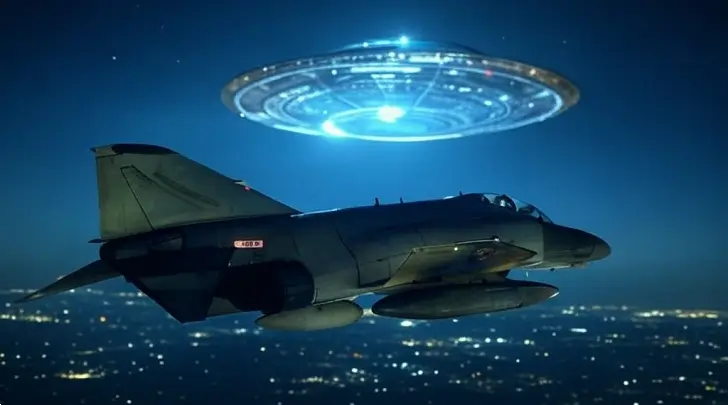Incident Overview
The Tehran UFO Incident occurred on September 19, 1976, over Tehran, Iran. It is one of the most well-documented UFO cases in history.
Iranian Air Force pilots and ground personnel reported a glowing object with extraordinary capabilities. Radar confirmation and electromagnetic interference added credibility to the event.
Official explanations suggested a misidentified celestial body, like Jupiter. However, detailed accounts and physical effects challenge this narrative.
The incident, backed by a declassified DIA report, is a cornerstone of UFO research. Its unresolved nature fuels debates about extraterrestrial visitation.
September 19, 1976
At 12:30 AM on September 19, 1976, residents in Tehran’s Shemiran district saw a bright, pulsating light. It emitted multicolored blue, green, red, and orange lights.
The Imperial Iranian Air Force received multiple calls at Mehrabad Airport. Air traffic controller Hossein Pirouzi confirmed the object was not a known aircraft or star.
The object hovered at about 6,000 feet, moving erratically. Its brightness and rapid color changes alarmed witnesses across the city.
Resident Mohammad Reza Shahbazi described it as a “glowing diamond” pulsing rhythmically. His account matched others, suggesting a single phenomenon.
The object’s proximity to restricted airspace concerned the IIAF. They decided to scramble fighter jets to intercept the unknown object.
Aerial Pursuit
At 1:30 AM, Captain Mohammad Reza Azizi piloted an F-4 Phantom II from Shahrokhi Airbase. Within 25 miles of the object, his jet’s systems failed, forcing him to abort.
A second F-4, piloted by Lieutenant Parviz Jafari, launched at 1:40 AM. Jafari saw a brilliant object, roughly Boeing 707-sized, with flashing diamond-patterned lights.
The UFO accelerated to 2,000–3,000 mph, outpacing the F-4. A smaller glowing orb detached, moving toward Jafari’s jet, causing further equipment malfunctions.
Jafari attempted to fire an AIM-9 missile at the orb. His weapons system failed, and the orb returned to the main object, which then darted away.
Radar operators at Mehrabad tracked the object’s erratic movements. The pursuit lasted about 20 minutes, leaving the pilots stunned.
Ground Observations
Ground witnesses, including air traffic controllers, observed the object from Tehran. Hossein Pirouzi saw it hover over a residential area, splitting into multiple lights.
A glowing orb detached from the main UFO, descending toward a dry riverbed near Rey. Some claimed it landed briefly, illuminating the area.
Resident Ali Rezaei reported a bright light and a low humming sound. He noted a brief power outage in his neighborhood.
General Yousefi observed the lights through binoculars. He noted the object’s rapid altitude changes, defying known technology.
No debris or burn marks were reported at the alleged landing site. The lack of physical evidence frustrated investigators.
Ground observations corroborated the pilots’ reports. The event’s visibility across Tehran added to its credibility.
Official Response and Data
The IIAF reported the incident to U.S. military advisors. A declassified DIA report from September 1976 called it “an outstanding report” with high credibility.
The DIA noted radar confirmation and electromagnetic interference. The report was shared with the CIA, NSA, and White House.
Iranian authorities downplayed the incident to avoid public panic. General Yousefi briefed the Shah but avoided public statements.
The U.S. Air Force and NASA suggested the object was Jupiter. This conflicted with its radar-tracked movements and physical effects.
No public Iranian investigation was disclosed, likely due to political tensions. The DIA report remains the primary official record.
The incident’s documentation, including radar data, sets it apart. The lack of follow-up fuels cover-up theories.
Investigation © Witness Accounts
Researcher Dr. Bruce Maccabee analyzed the DIA report and interviewed Parviz Jafari. He concluded the object’s behavior was not conventional.
Jafari, later a general, described the UFO as technologically advanced. He reported headaches post-encounter, though no medical link was confirmed.
Hossein Pirouzi provided radar logs confirming the object’s erratic movements. His testimony aligned with the pilots’ observations.
In 2007, Jafari spoke at a UFO conference in Washington, D.C. He reiterated the object’s extraordinary speed and maneuverability.
A 2025 claim by a retired Iranian officer suggested U.S. advisors confiscated radar tapes. This unverified claim renewed interest in the case.
No verified photographs or debris exist. The reliance on testimony and radar data leaves the case unresolved.
Impact and Legacy
The Tehran UFO Incident is a landmark in UFO research. Its military witnesses and documentation draw comparisons to Roswell and Rendlesham.
Documentaries, like a 2004 History Channel special, featured Jafari’s testimony. A 2015 UFO TV series highlighted the case’s global significance.
In Iran, political sensitivities limit discussion. Yet, the case remains a point of pride among UFO enthusiasts.
The 1976 event reinforced beliefs in advanced extraterrestrial technology. Its Cold War context fueled speculation about secret projects.
A 2025 podcast claimed new eyewitnesses from Tehran’s suburbs. These unverified reports keep the incident relevant.
The Tehran Incident endures as a compelling mystery. Its detailed records challenge conventional explanations.

